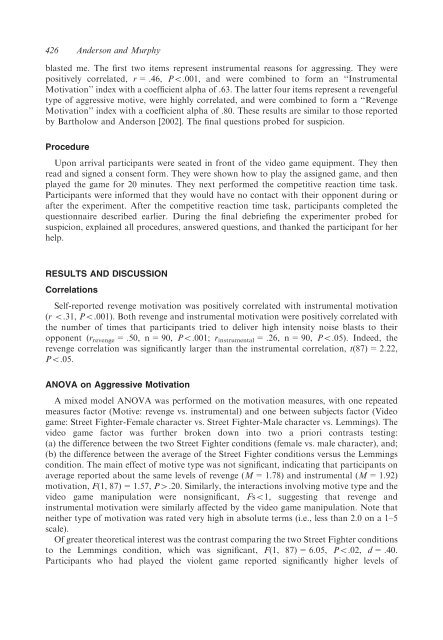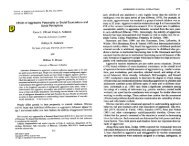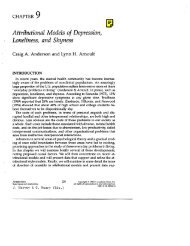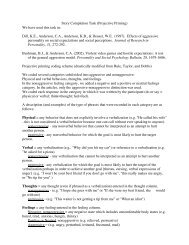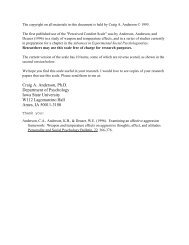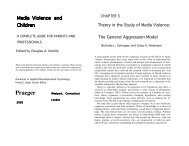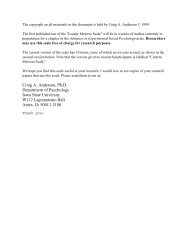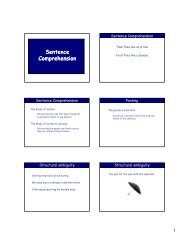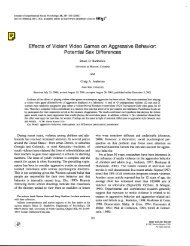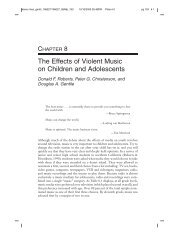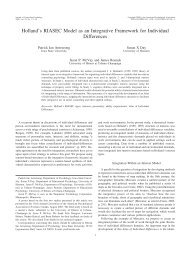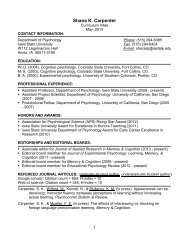Violent Video Games and Aggressive Behavior in Young Women
Violent Video Games and Aggressive Behavior in Young Women
Violent Video Games and Aggressive Behavior in Young Women
You also want an ePaper? Increase the reach of your titles
YUMPU automatically turns print PDFs into web optimized ePapers that Google loves.
426 Anderson <strong>and</strong> Murphy<br />
blasted me. The first two items represent <strong>in</strong>strumental reasons for aggress<strong>in</strong>g. They were<br />
positively correlated, r = .46, Po.001, <strong>and</strong> were comb<strong>in</strong>ed to form an ‘‘Instrumental<br />
Motivation’’ <strong>in</strong>dex with a coefficient alpha of .63. The latter four items represent a revengeful<br />
type of aggressive motive, were highly correlated, <strong>and</strong> were comb<strong>in</strong>ed to form a ‘‘Revenge<br />
Motivation’’ <strong>in</strong>dex with a coefficient alpha of .80. These results are similar to those reported<br />
by Bartholow <strong>and</strong> Anderson [2002]. The f<strong>in</strong>al questions probed for suspicion.<br />
Procedure<br />
Upon arrival participants were seated <strong>in</strong> front of the video game equipment. They then<br />
read <strong>and</strong> signed a consent form. They were shown how to play the assigned game, <strong>and</strong> then<br />
played the game for 20 m<strong>in</strong>utes. They next performed the competitive reaction time task.<br />
Participants were <strong>in</strong>formed that they would have no contact with their opponent dur<strong>in</strong>g or<br />
after the experiment. After the competitive reaction time task, participants completed the<br />
questionnaire described earlier. Dur<strong>in</strong>g the f<strong>in</strong>al debrief<strong>in</strong>g the experimenter probed for<br />
suspicion, expla<strong>in</strong>ed all procedures, answered questions, <strong>and</strong> thanked the participant for her<br />
help.<br />
RESULTS AND DISCUSSION<br />
Correlations<br />
Self-reported revenge motivation was positively correlated with <strong>in</strong>strumental motivation<br />
(r o.31, Po.001). Both revenge <strong>and</strong> <strong>in</strong>strumental motivation were positively correlated with<br />
the number of times that participants tried to deliver high <strong>in</strong>tensity noise blasts to their<br />
opponent (r revenge = .50, n = 90, Po.001; r <strong>in</strong>strumental = .26, n = 90, Po.05). Indeed, the<br />
revenge correlation was significantly larger than the <strong>in</strong>strumental correlation, t(87) = 2.22,<br />
Po.05.<br />
ANOVA on <strong>Aggressive</strong> Motivation<br />
A mixed model ANOVA was performed on the motivation measures, with one repeated<br />
measures factor (Motive: revenge vs. <strong>in</strong>strumental) <strong>and</strong> one between subjects factor (<strong>Video</strong><br />
game: Street Fighter-Female character vs. Street Fighter-Male character vs. Lemm<strong>in</strong>gs). The<br />
video game factor was further broken down <strong>in</strong>to two a priori contrasts test<strong>in</strong>g:<br />
(a) the difference between the two Street Fighter conditions (female vs. male character), <strong>and</strong>;<br />
(b) the difference between the average of the Street Fighter conditions versus the Lemm<strong>in</strong>gs<br />
condition. The ma<strong>in</strong> effect of motive type was not significant, <strong>in</strong>dicat<strong>in</strong>g that participants on<br />
average reported about the same levels of revenge (M = 1.78) <strong>and</strong> <strong>in</strong>strumental (M = 1.92)<br />
motivation, F(1, 87) = 1.57, P4.20. Similarly, the <strong>in</strong>teractions <strong>in</strong>volv<strong>in</strong>g motive type <strong>and</strong> the<br />
video game manipulation were nonsignificant, Fso1, suggest<strong>in</strong>g that revenge <strong>and</strong><br />
<strong>in</strong>strumental motivation were similarly affected by the video game manipulation. Note that<br />
neither type of motivation was rated very high <strong>in</strong> absolute terms (i.e., less than 2.0 on a 1–5<br />
scale).<br />
Of greater theoretical <strong>in</strong>terest was the contrast compar<strong>in</strong>g the two Street Fighter conditions<br />
to the Lemm<strong>in</strong>gs condition, which was significant, F(1, 87) = 6.05, Po.02, d = .40.<br />
Participants who had played the violent game reported significantly higher levels of


